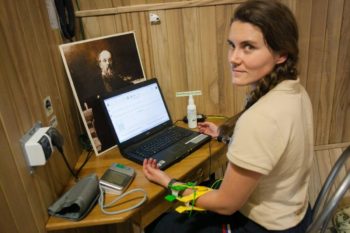
Credit: IBMP RAS
A simulated Moon mission has been wrapped up by the Institute of Biomedical Problems of the Russian Academy of Sciences (IBMP RAS) in cooperation with NASA.
The 17-day experiment focused on long-term space travel, but centered on use of the proposed cis-lunar Deep Space Gateway. Eyed for the 2020s, this facility could be a collaborative partnership between Roscosmos, Russian’s federal space agency, and NASA.

Credit: IBMP RAS
Called the SIRIUS (Scientific International Research in Unique Terrestrial Station) project, the simulated space voyage began on November 7, involving three men and three women. SIRIUS-17 crew members carried out an agenda of scientific experiments during their mission. The crew of the isolation experiment: Kikina Anna Yuryevna; Luchitskaya Elena Sergeevna; Lysova Natalia Yuryevna; Rukavishnikov IlyaVyacheslavovich; Serov Mark Vyacheslavovich and Viktor Fetter.
Personal space
The SIRIUS -17 mission focused on a simulated flight to the Moon. This international isolation experiment mimicked travel to the Moon, surveying the lunar surface by rovers, and trekking back to Earth.
During the 17-day isolation, scientists studied the distribution of roles in teamwork and leadership, interaction between men and women, their personal space, biochemistry. New systems of psychological support were applied, and new principles for the distribution of elbow room in spacecraft were also introduced.

Credit: IBMP RAS

Credit: IBMP RAS
Follow-on missions
NASA is also slated to work with the IBMP to conduct at least three follow-on missions: a four-month mission in 2018, an eight-month mission in 2019, and a 12-month mission in 2020.

Credit: IBMP RAS

MARS 500 Session training in the IMBP module.
Credit: IBMP RAS
The Moscow-based IBMP RAS complex was previously utilized for the “Mars 500” project – a set of “flights” carried out 2007-2011 that included a 520-day simulated voyage to the Red Planet.
IBMP maintains international scientific and technical ties under cooperative agreements with space agencies and research centers in the U.S., France, Germany, Italy, Canada, Japan, Austria, the Republic of Korea, China and other countries.
The SIRIUS missions are the first time NASA’s Human Research Program (HRP) partners with Russia’s IBMP Ground-based Experimental Complex (NEK) to conduct a series of analog missions.


I wonder if it’ll be the same crew each time? Do you know? I was thinking surely personalities would come into play when analysing situations like this so using the same crew would benefit this but they would need more rest time between the longer missions?